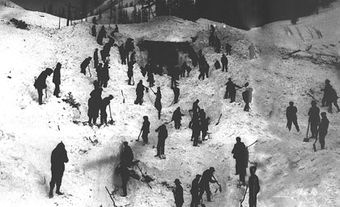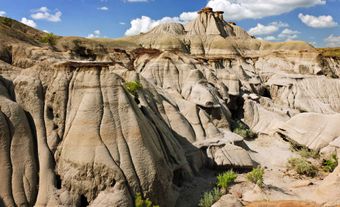Drumlin
Drumlin, smooth, half egg-shaped or ellipsoidal hill which formed beneath Quaternary Glaciers. Drumlins [Gaelic druim, "hill"] were first described in Ireland. They lie parallel to the direction of ice movement, the blunt (stoss) end facing up-glacier, the lee sloping down-glacier. Drumlins may be up to 50 m high and several kilometres long, with an average length/width ratio of 2 or 3 to 1. Highly elongated drumlins are often called drumlinoids. Drumlins occur in broad fields or swarms, up-glacier from major end Moraines in Europe and North America. Swarms of several thousands occur in Nova Scotia, southern Ontario and the Thelon Plain of the Northwest Territories and Nunavut; smaller groups occur in most other provinces.
Drumlins may be composed of layers of till (sediment deposited by a glacier), frequently clay-rich, in which the pebbles are oriented subparallel to drumlin elongation and the direction of ice flow, although many drumlins have cores of stratified sand, boulders or bedrock. Rock drumlins are rock outcrops smoothed by ice to a drumlin shape. Scientists are not certain how drumlins originated. The "dilatancy" theory postulates that drumlins were initiated beneath ice of a critical thickness, down-glacier from high basal pressure zones and up-glacier from moraine deposition, where till expanded, forming hummocks.
Other hypotheses suggest that subglacial crevasses, frost heave, helical ice motion or water loss from saturated till initiated hummocks. Drumlins with a core of stratified sediments are glaciofluvial in origin, formed by deposition in cavities which were cut in the base of the ice by a large discharge of subglacial melt water. All theories hold that the hummocks were subsequently enlarged by layers of till which were plastered on and streamlined by the ice sliding over.
See also Glaciation.

 Share on Facebook
Share on Facebook Share on X
Share on X Share by Email
Share by Email Share on Google Classroom
Share on Google Classroom


